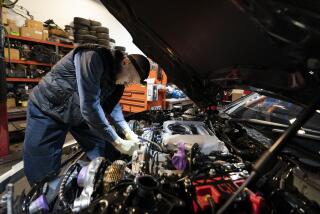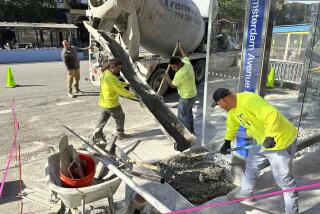U.S. economic recovery is expected to gain strength in 2014
WASHINGTON — After six years of a gloomy recession and shaky recovery, the U.S. economy looks poised to regain its glow next year with stronger job growth, bigger income gains for more people and a resurgence of homeowners moving up into new digs.
The overall economic outlook for the U.S. has improved sharply in recent weeks amid a string of surprisingly robust economic data: Businesses have stepped up hiring, new factory orders from abroad are at a two-year high and consumers have been flocking to car lots and restaurants.
State and local governments that not long ago were in massive retrenchment are spending more too.
“We could see the unemployment rate down to 6% this time next year,” said Robert Kleinhenz, chief economist for the Los Angeles County Economic Development Corp.
That would be a full percentage point below the current rate and, in some analysts’ views, close to full employment.
Some experts say economic growth could be even stronger next year now that the House has approved the bipartisan two-year budget deal.
Not only would the agreement undo most of the sequestration spending cuts in the short term, it would lower a major confidence hurdle for businesses, some of which complained that they have been hamstrung by the federal government’s repeated budget standoffs and partisan warring.
“If that is dealt with, that goes a long way toward reducing uncertainty,” said David Hannah, chief executive of Reliance Steel & Aluminum Co. in Los Angeles.
Even before the budget deal, Hannah was preparing for a marked step-up in business next year — and more aggressive hiring to add to his company’s worldwide workforce of about 14,000.
Hannah said Reliance’s orders accelerated in the second half of this year, which usually happens in the first half. He said the company got a good boost from the buoyant auto industry as well as its other mainline customers: aircraft makers, oil and gas firms and electronics companies.
Reliance’s biggest source of revenue, nonresidential construction, has been lagging since the recession, but Hannah sees more demand next year as increased home-building creates the need for more supermarkets, doctors’ offices and other commercial and industrial development.
“We are looking for 2014 to be a better year overall in both sales and profits than 2013,” he said.
All in all, many economists now see economic growth climbing to a solid 3% next year, a significant improvement from the 2% average annual pace that the economy has been stuck on for the last 4 1/2 years.
An acceleration to 3% would probably push up U.S. job growth to 250,000 a month on average, from a monthly average of 190,000 over the last 12 months, Kleinhenz said.
At that pace, the nation would recover all the jobs lost in the recession by the end of 2014. And it would push down the jobless rate closer to the 5.5% to 6% range that some now see as the potential long-term unemployment rate.
Global competition and the increasing role played by computers and other advanced technologies have reduced the need for mid-level workers with no special skills, which has forced some economists to rethink their old assumption that full employment meant no more than 4% or 5% joblessness.
Many business executives and analysts remain cautious about the outlook.
One reason is that around this time each of the last four years, many top economists, including those at the Federal Reserve, put out rosy forecasts that the recovery would shift into higher gear.
But no sustained pickup ever materialized as still shell-shocked consumers sat on their hands and businesses on their piles of unspent cash. A host of political problems at home and shocks from the Arab world, the Eurozone and Asia took turns knocking down growth.
Although the external and internal conditions look better — Europe is recovering and U.S. debt burdens are lighter — there are new risks on the horizon.
Perhaps the biggest is that interest rates have risen since summer and are likely to tick higher as the Federal Reserve begins to pull back on its $85 billion in monthly bond purchases, a key stimulus aimed at spurring the economic recovery.
It’s uncertain how investors and financial markets will react as the central bank, with Janet L. Yellen set to be its new chair, tries to wean the economy from years of easy-money policies.
“That’s the one critical thing that may potentially lead to some slowing,” said Timothy Gill, deputy chief economist at the National Electrical Manufacturers Assn.
The Fed’s bond-buying and other stimulus efforts have helped drive stock prices to record highs, which in turn power more investments and spending, especially among the richest Americans.
Fed reports show that in the third quarter, U.S. households as a whole had recouped nearly all of the wealth lost during the Great Recession, although that can’t be said of the average household.
Analysts doubt such hefty stock appreciation will continue next year. Wealth is more likely to be generated by home equity gains and thus spread proportionately a little more to middle-class Americans.
The coming year also could mark a new stage in the housing market’s recovery: “2013 was the year of the investor,” said Jed Kolko, chief economist at the real estate website Trulia, “but 2014 will be the year of the repeat home buyer.”
That would signal a return to a healthier housing market, fueled in significant part by existing owners who finally have regained enough home equity to seek bigger, better quarters.
“Rising prices and a reduction in negative equity are bringing willing sellers back to the market,” said Paul Diggle, an analyst at Capital Economics.
With more supply coming on line — plus higher mortgage rates and fewer investor purchases — house price appreciation is likely to slow to 4% next year from a projected 11% this year, he said.
Still, stronger home building will continue to juice the economic recovery. Increased exports and business investments will help too. And unlike the last two years, the government sector isn’t likely to be a big drag on growth.
That leaves consumer spending, the single biggest component of the U.S. economy, accounting for about 70% of gross domestic product, or the nation’s total economic output.
Despite the strong rebound in car sales, personal spending on the whole has been mediocre, growing at an annual rate of about 2% in the last three years. But some analysts say next year could be a breakout year for the U.S. consumer.
On one side, households are in better shape to spend. Many have paid down their credit card and other debts over the last few years; their average debt-servicing burden is now as low as it has been in a generation.
Layoffs have fallen to pre-recession levels, and many companies are operating with bare-bone staffs. As sales grow, it won’t be just head counts that rise, said Shawn DuBravac, chief economist for the Consumer Electronics Assn. Employers also will pay more to retain their most productive and profitable workers, he said.
“The share of corporate profits going to employees is at a historical low,” DuBravac said. “That isn’t sustainable.”
On the other side, many U.S. households have put off buying cars, appliances and other big-ticket goods. Young adults have delayed moving out on their own or starting families.
“For the last several years they’ve really been in a mode of retrenchment and de-leveraging,” economist Gill said about the average consumer.
Now, however, he said, “both the capacity to spend and pent-up demand across a wide array of products are going to lead to stronger consumer spending gains.”








